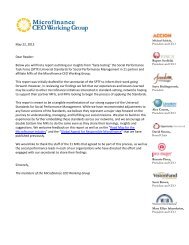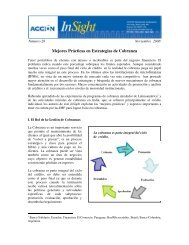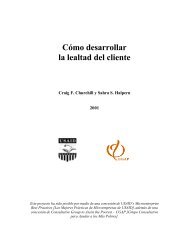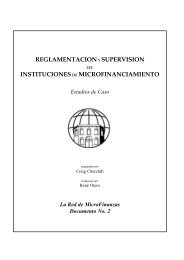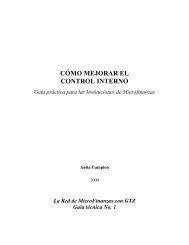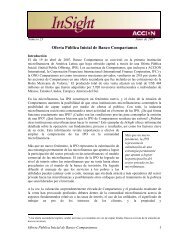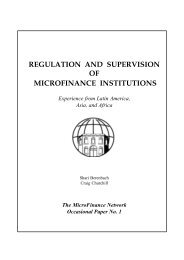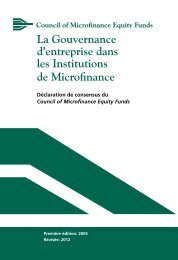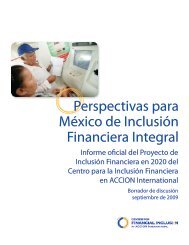Accelerating Financial Inclusion through Innovative Channels
Accelerating Financial Inclusion through Innovative Channels
Accelerating Financial Inclusion through Innovative Channels
Create successful ePaper yourself
Turn your PDF publications into a flip-book with our unique Google optimized e-Paper software.
Alternative <strong>Channels</strong> WorkstreamDecember 2009Number 27<strong>Accelerating</strong> <strong>Financial</strong> <strong>Inclusion</strong> <strong>through</strong> <strong>Innovative</strong> <strong>Channels</strong>10 Obstacles for MFIs Launching Alternative <strong>Channels</strong>—and What Can Be Done About ThemRarely a day goes by without someone mentioning how financial inclusion can be boosted bynew delivery channels, such as ATMs, banking agents, and mobile phones. Yet for all the talkabout reaching the “unbanked” and other low-income groups, it is banks, mobile operators, andretailers that have been experimenting with new delivery systems to reach the poor. As the groupthat is closest to the niche segment, microfinance institutions (MFIs) seem conspicuously absentfrom the discussion.Or are they? Based on ACCION’s experience in working with over a dozen microfinance partnerson delivery channels in Latin America, Asia, and Africa, as well as observations of other MFIs(see interview list in the acknowledgements), it appears that while some experimentation isindeed occurring, significant obstacles remain.This paper outlines ten challenges that are holding MFIs back from deploying alternativechannels and provides a roadmap for MFIs—and broader stakeholders—who seek to overcomethese hurdles. This roadmap is relevant not only for MFIs and MFI networks but also for thosewho provide the enabling environment for financial inclusion, including social investors, bankingregulators, grant-making institutions, and prospective partners, such as commercial banks, mobileoperators, and technology vendors. The paper concludes with a description of competitiveadvantages that MFIs have in this space to make them more effective in reaching low-incomegroups using innovative channels.Introduction to Alternative <strong>Channels</strong>Defining Alternative <strong>Channels</strong>For much of its 30-year history, microfinance has been limited to the standard branch-and-loanofficermodel of delivering credit. Currently, microfinance institutions are considering nontraditional,or alternative, ways of distributing credit and other financial services to the poor. Thisfunction is typically referred to as Alternative <strong>Channels</strong>. 11 The term “branchless banking” has been used to describe this, but we prefer using “alternative channels,” which isthe terminology employed in the banking sector. The term “branchless banking” implies that there is no need for abranch, but branches are still central to MFI operations—especially for operating a savings product and crucially forbuilding customer trust with the institution.
Banking channels fall into two main categories: direct and indirect. Direct channels are those thatthe bank “owns” or has main control over. There are two kinds of direct channels: location-baseddirect channels are those that occupy a physical (though not necessarily fixed) presence, whereasremotely-based are not. Thus channels—such as branches, kiosks, roaming vans, and businessunits—are examples of the first; Internet, call centers, and IVR (Interactive Voice Response) areexamples of the second. It should be noted that remote channels lack face-to-face contact betweenthe institution and the customer, an important consideration when addressing low-incomesegments and gaining their trust.Indirect channels are those that the financial institution does not wholly control. Usually thismeans that the bank needs to engage in some sort of partnership with a third party. Examplesinclude issuing a Mastercard prepaid card, working with a mobile operator to facilitate mobilebanking, joining a national switch and deploying ATMs, or leveraging a pharmacy chain as part ofa banking agent program. An important focus of indirect channels is thus on working with and<strong>through</strong> third parties to reach customers and, consequently, outsourcing a significant part of thecustomer experience to those parties. 2The table below provides the key features of the types of channels and the main variables to keepin mind.Table 1: Types of Alternative <strong>Channels</strong> and Main FeaturesChannelTypeKey FeaturesTechnologicalIntensityDIRECTLocationDIRECTRemoteINDIRECT• Real-estateheavy• Face-to-facecustomerinteraction• Technology-Based• HighInvestment• 3 rd PartyEngagement• RegulatoryAmbiguityOperational/Real EstateIntensityRegulatoryBoldness3 rd PartyManagement †Long-TermImplementation ‡High Low Low Low (typically) Low (3-6months)Low Medium-High Low-MediumMediumHigh(synchronization)High(vague,changing)Low-Medium(mainlytechnicalconsultants)High (agents,suppliers,alliances)Medium (6-12months)High (6-24months)† Includes consulting firms, agents, suppliers, and strategic alliances.‡ Approximate average durations. Figures are for comparative reasons; actual durations may vary significantly.2 It should be noted that not all channels can be neatly compartmentalized in the above categories. For example, if aMFI were to own, manage, and deploy its own ATMs, it can be reasonably considered a direct channel. The purpose ofelaborating the different types is not to tie specific channels with specific categories, but rather to illustrate that thebroad categories have different implications in terms of implementation.2
Alternative <strong>Channels</strong> WorkstreamMotivation of Alternative <strong>Channels</strong>The excitement of new delivery channels is due to their apparent promise to bring about twobreak<strong>through</strong>s of major importance for microfinance. The first is that certain delivery channelsoffer the possibility of massive outreach to people in locations that remainunderserved, especially those in hard-to-reach rural areas. Some channels, including retail agentssuch as supermarkets or drug stores that act as banking agents, may bring the industry closer tosignificantly serving more of the poor.The second break<strong>through</strong> involves dramatic cost reduction. With an operating model chieflybased on personal, one-on-one relationships, microfinance is remarkably human-resourceintensive, with labor costs sometimes accounting for almost half of operating expenses. Ascompetition increases, MFIs hope that different channels may reduce—though not eliminate—their dependence on branch staff and offer a balance between the classic personalized service andan emerging “transactional” service, such as cell-phone banking.Alternative channels candramatically reducecosts and greatlyexpand outreach offinancial services to thepoor.There are several more specific motivations for diversifying a MFI’s channels beyondthe branch:• Customer acquisition and retention: penetrating new markets or servicing hard-to-reachareas.• Product diversification: offering valuable products, such as micro-savings andremittances, profitably and efficiently.• Operational efficiency: reducing branch congestion and maximizing efficiency of branchtellers and loan officers.• Cash reduction: reducing cash in the financial system to save money, provide moretransparency, be less vulnerable to fraud risk, and be safer for the client.With few established models even in the retail-banking industry, many of these alternativechannels are new to microfinance, and thus a high degree of experimentation is currentlyunderway. It remains to be seen which channels will have the transformational impactdescribed above.10 Obstacles—and Solutions—for MFIs in Implementing Alternative <strong>Channels</strong>Despite a substantial amount of awareness and interest in alternative channels, few MFIs have runpilots, and only a handful have successfully rolled out new models. By “success” we mean notonly that the channel is functioning from an operational and a technological standpoint, but thatcustomer uptake and usage is significant, and the solution is financially viable. This is based notonly on ACCION’s own experience consulting to its MFI partners but also on the comprehensiveinterviews it conducted with the largest MFI networks (which collectively support roughly 120MFIs around the world) and with individual MFIs in nearly a dozen countries. Why, then, do thereappear to be few notable examples of MFIs participating in these potentially beneficial channels?3
While some challenges—such as regulation, technology, and customer adoption—are frequentlymentioned, others are less obvious and possibility pose greater roadblocks to MFIs. Following areten main challenges facing MFIs and what are needed to overcome the hurdles.1. Alternative channels is still an emerging fieldUnlike other functions, such as risk management, branch operations, or marketing, alternativechannels is a relatively new field, even in the banking sector. There are few reference points,especially in the microfinance sector, and even fewer success stories—and almost none are widelycommunicated across borders or regions. This means that senior executives at MFIs often have anincomplete understanding of alternative channels and how they might fit in their businesses andunclear ideas of what benefits they may bring.Lack of successful MFIexamples of alternativechannels is leading touncertainty andhesitation.This “Catch-22”—few successful reference points discourage experimentation, leading to fewpilots that could result in success stories—is present in all sectors, not just microfinance, and isoften broken by a single, highly-publicized “big win.” The most telling example is Safaricom’shugely successful M-Pesa product in Kenya, which has catalyzed experimentation among hithertoreluctant mobile operators.What’s NeededDetailed case studies of MFIs using alternative channels would help spur exploration andexperimentation among the many MFIs that are curious about their potential but unsure of theiradvantages. Few of the current studies to-date on channels have been from the perspective ofMFIs, which in turn makes the available insights more difficult for MFIs to apply in their context.Specific tools, such as institutional diagnostics or the use of benchmarks for typical customerusage of certain channels, would help MFIs establish the viability of implementing certainchannels. Preparing more comprehensive aids, such as channel-specific manuals (as has been donefor product lines like savings, housing, and insurance), are time-consuming but would beenormously useful as a step-by-step guide for MFIs.Greater disseminationof MFI case studies,combined with channelinnovation grants,would spurexperimentation.Much of the burden to gather and disseminate information to the microfinance community falls onthose groups that conduct and publish research and, in particular, on those that take an industryview. For example, Microsave has published several helpful briefs on mobile banking that covertopics such as roll-out strategies, technology, and customer adoption. MFIs and MFI networks canalso be pro-active by writing blogs, publishing material on websites, and contacting researchhouses to help disseminate findings.Grant-making organizations also have a valuable role to play. They could provide funds forresearchers to undertake the analytical and dissemination work so crucially needed. In moresophisticated cases, they could set up challenge funds to catalyze innovation and break the Catch-22. For example, the genesis of Vodafone’s M-Pesa was a <strong>Financial</strong> Deepening Challenge Fundset up by the United Kingdom’s DFID (Department for International Development) in 2003,which encouraged the private sector to cost-share development projects. The roughly £1 million4
Alternative <strong>Channels</strong> Workstreamfunding that DFID provided was matched by Vodafone and created the momentum inside themultinational to pilot a project around mobile phones and microfinance loan repayments.2. Regulatory frameworks for alternative channels are ambiguous or restrictiveRegulation is often ambiguous or restrictive on new delivery channels. As country regulatorsgrapple with the pace and hype of channels, their first moves have often been to place unclear orconservative guidelines, which in turn slow or stifle innovation. For example, until recently theReserve Bank of India (RBI) did not permit regulated microfinance entities—such as SKS,BASIX, and Spandana—to be banking correspondents of big banks or to leverage their ownnetwork of banking agents. The RBI even adjusted its draft guidelines on prepaid instruments thatlimited these microfinance institutions to issuing cards that could only be used for purchases ofgoods at participating merchants, rather than allowing cash withdrawal at a branch or ATM,greatly restricting the usefulness of the channel to the poor. In Mexico, regulators approvedbanking agent guidelines only in 2008; in the past, some financial institutions (e.g., Banamexsince 2001) had taken compliance risks to pilot the channel in the absence of supportive regulatoryframeworks. Meanwhile, the Bank of Ghana has insisted that all interbank transactions be cleared<strong>through</strong> its new payment switch and that all banks and savings and loan companies issue—free-ofchargeand without any government subsidies—prepaid smart cards to any consumers that requestthem. In all these cases, lack of supportive regulation has meant missed opportunities for MFIs tospread innovation.Some regulators around the world, though, have been making advances. South Africa successfullyinitiated a three-tiered “Know Your Customer” (KYC) norm for account opening, primarily tospur electronic banking. Brazil’s banking superintendency instituted banking agent policies in2001, which led banks to create over 100,000 new distribution points covering every municipality;a “wave” of supportive banking agent legislation has rippled out to neighboring countries,including Peru, Colombia, Chile, and Bolivia, as regulators seek to replicateBrazil’s success.A country’s regulation,or lack thereof, ofalternative channelsgreatly affects theability for MFIs toconsider them.In short, a country’s regulation, or lack thereof, greatly affects the ability for MFIs to consider analternative channel, let alone implement one. Depending on their tolerance of regulatory risk,which is usually low, many MFIs prudently opt not to experiment unless guidelines are both clearand supportive of their aims.What’s NeededThe onus naturally falls on banking regulators and superintendencies to establish clear andsupportive policies. For alternative channels, these usually encompass guidelines on anti-moneylaundering and combating the financing of terrorism (AML-CFT), KYC norms, and electronicmoney (e.g., definition of electronic money, types of issuers) and banking agents (e.g., types ofagents, insurance policies, maximum amounts). Moreover, regulators should work closely with therelevant stakeholders—including not only banks and MFIs but also mobile network operators,5
etail chains, and payment providers—to design and test regulations. A risk-based, rather thanrule-based, approach is often helpful. For example, rather than insisting that a low-incomecustomer provide standard KYC documents to open an electronic account, regulators could reduceKYC requirements for low-value accounts, which hold little risk of money laundering andterrorism financing.Two success stories are worth noting primarily for the approach the central banks took toregulation of alternative channels. In the Philippines, the Central Bank collaborated closely withGlobe and SMART, the country’s two mobile operators, to develop a framework for mobilebanking that incorporated consumer protection into the mobile-operator business model. TheCentral Bank issued guidelines in 2005, shortly after the launch of Globe’s G-Cash product, and itcontinues to engage with a variety of stakeholders today, including most recently the equity stakethat Globe took in one of the country’s savings banks.Regulators who followa collaborative, proactive,and risk-basedapproach in craftingguidelines wouldremove one ofthe major obstacles forMFIs to develop transformationaldeliverychannels.Meanwhile, the Reserve Bank of Pakistan has taken a pro-active approach and establishedtransparent and detailed guidelines for banking agents and mobile banking well-ahead of anylarge-scale implementation. It recently joined forces with the country’s telecommunicationauthority and set up a joint regulatory committee to propose modifications to the mobile bankingregulatory framework. The bank also created a cross-industry, multi-sector “Stakeholders Group”to address product, operational, and technical issues for mobile banking. If regulators in othercountries can follow a similarly collaborative, pro-active, and risk-based approach to craftsupportive guidelines, it would remove one of the major obstacles for MFIs to developtransformational delivery channels.Other stakeholders also have roles to play. MFIs and networks should actively engage regulators,rather than avoiding them or hoping to find loopholes in regulation. Regulators are willing—andin some cases eager—to work with practitioners to explore innovations that can improve financialaccess. Sa-Dhan, an association that represents microfinance interests in India, made a compellingcase to the Reserve Bank of India to rethink its guidelines on banking correspondents. Whenthe regulators revised the guidelines several weeks later, they incorporated several ofSa-Dhan’s recommendations.3. Poor customers are initially reluctant to adopt technologically enabled channelsMany poor customersinitially do not trustfinancial servicesdelivered <strong>through</strong>technologically-enabledchannels.MFIs face a particular challenge with alternative channels because their customer bases aregenerally lower-income, less educated, and have lower familiarity with financial services andtechnology than mainstream banking customers. Especially for indirect channels for banking orpayments, MFI customers may not understand the benefits of a prepaid card, feel comfortableusing a cell phone for sending money, or trust a gas-station attendant to deposit money in theirsavings account. This applies both for the trial of the channel as well as on-going usage.In customer market research that ACCION has conducted in Peru, Guatemala, Ghana, China, andIndia, “lack of trust” in alternative channels has been a familiar refrain for certain, though not all,segments of the low-income population. This is especially the case if the interaction involves6
Alternative <strong>Channels</strong> Workstreamtechnology, a non-cash transaction, or little human interface. Mobile banking, which has all threecharacteristics, may thus be the most difficult channel to gain momentum among the base of thepyramid. However, when mobile banking does overcome the initial inertia, its benefits of safety,speed, and cost are readily apparent, and the service can gain traction very rapidly among certainlow-income segments, as examples in Kenya and the Philippines have demonstrated.What’s NeededMFIs should base decisions more on properly designed qualitative and quantitative marketresearch to understand their customers. Too often managers in MFIs rely on anecdotes or theirinstinct in offering products to their customer base; this is not only insufficient, it might also bemisleading, and too often it glosses over the nuances of customer behavior. Properly designedcustomer research allows the MFI to segment its market and carefully design the channel to meetthe segment’s needs. For example, for a project involving prepaid cards for remittance paymentswith one of Guatemala’s largest banks, ACCION identified and evaluated three main targetcustomer segments from comprehensive quantitative research it conducted. Along with sociodemographicvariances, the segments had different needs and wants; ACCION thus designeddifferent product and marketing strategies to respond to each segment’s individual needs.Two other tactics to increase adoption are also starting to emerge. The first is simplicity of thecustomer value proposition: while it is tempting to offer an array of services <strong>through</strong> multiplechannels, a best practice is to offer a single, compelling benefit to the customer (e.g., “send moneyhome” was the key benefit articulated to Safaricom’s M-Pesa’s target market; “we’re everywhereBrazilians are” for Lemon Bank’s network of retail agents). The second is that many customersneed to “experience” the alternative channel—as in, convince themselves that it truly functions asthe marketing messages promise—a number of times before employing it regularly on their own.In practical marketing terms, this means that MFIs may want to reward customers for minimumusage (e.g., make at least 3 transactions this month and receive a gift) or assist low-incomecustomers in using ATMs when they are first deployed.Proper marketsegmentation, productsimplicity, andstrategies to increaseinitial usage can greatlyovercome the initialmistrust customers havewith alternativechannels.There has been much discussion about the need for client education and financial literacy at thebase of the pyramid, both for microfinance in general and for alternative channels in particular. Inpersontraining and written materials are indeed important and crucial for any successfuldeployment of alternative channels. That said, client education is not a panacea; alone it cannotfundamentally change behavior from reluctance and fear into eager adoption of a channel. Basedon research conducted by ACCION, while certain customer segments can be coaxed to tryalternative channels using a mix of marketing promotion and client education programs, otherswill reject them altogether.4. Technological infrastructure remains weakTechnology, both inside the MFI and in the external infrastructure, is another barrier foralternative channels. The first reason is the actual stability and resilience of the core bankingsystem—not all MFIs have banking grade systems capable of handling large volumes of7
transactions (e.g., as in the case for mobile banking) and reconciliation errors may occur. Indirectchannels—such as ATMs, agents, or mobile phones—necessarily mean that transactions areinitiated remotely. Thus the system must be resilient as well, with little or no down-time and aback-up system in place, as customers who are using such channels are likely away from nearbyMFI branches (or making the transaction outside of business hours) and would not be able to visita branch in case the indirect channel malfunctions.Indirect channelsespecially requirerobust core bankingplatforms andcommunicationsystems.Indirect channels also require integration and data synchronization between third-party platformsand those of the MFI. For example, a MFI’s banking application must “talk” to the partner’s ITsystem using the same communication protocol. For mobile banking, a MFI needs to connect to amobile operator’s platform either directly or, more likely, <strong>through</strong> the black box of a mobiletechnologyvendor that provides application development and switching capability. Experiencehas shown that, though manageable, this is one of the biggest hurdles to overcome. The security inrelaying a customer’s personal and financial data to the MFI is another concern, and, depending onthe risk threshold set by the Central Bank and the MFI’s own risk unit, MFIs must ensure that anadequate level of encryption and safe storage is employed so that data cannot be intercepted orotherwise compromised.Finally, the infrastructure in the country or region that is needed to support certain alternativechannels is not always reliable. This includes sporadic power supply, a weak wireless telecominfrastructure, and the limited availability of a national switch to process electronic transactionsacross multiple payment platforms. Almost all well-developed ATM networks, for example, relyon these three characteristics to allow customers real-time access to their funds innearby locations.What’s NeededMFIs must ensure theirIT platform is adequateto support channels,and ideally bring onboard a reputablevendor to supportthem in design anddeployment.If they do not have one already, MFIs should carefully consider upgrading their IT platform toeither a customized or off-the-shelf core banking solution that is banking grade and can safelysupport multiple payment modules as well as significantly greater transaction volume.Furthermore, it is highly recommended that the MFI engage a reputable technology vendor thatcan offer a turn-key solution (systems integration, application development, front-end support,switching capabilities, data processing, etc.), as these functions are beyond the core competency ofall but a handful of MFIs.Improving the country’s energy and communications infrastructure is imperative for certainremote channels to flourish, though naturally financial inclusion is but one of many infrastructuredependentactivities which government decision-makers must consider, and infrastructuretypically takes years to improve to a satisfactory level. In the meantime, MFIs may have toconsider alternatives—such as back-up power generators, fixed-line communications, and multipleinterfaces with banks (in lieu of a broad switch)—that allow them to offer a robust and reliablebanking channel to their customers.8
Alternative <strong>Channels</strong> Workstream5. Dedicated and specialized human expertise for alternative channel projects is lackingThe cross-functional nature of alternative channels typically involves many aspects of a MFI’soperations, bringing the technology, commercial, and marketing departments into a close workingrelationship for both strategy and implementation. Not all institutions have the resource capacityavailable to do so in-house. In addition to dedicating staff, MFIs must have or developcapabilities, such as cross-functional collaboration, solid project management to supervise alengthy implementation process, management of an extended team, and senior-level commitmentto bring the project to fruition.Few MFIs have in-housecapacity and expertiseto successfullyimplement alternativechannels.Moreover, alternative channels require specific knowledge, skills, and experience. Because of itsrelative infancy in the microfinance sector (and for certain channels, in all sectors), it isunderstandably not always common to find personnel with direct experience within the MFI.What’s NeededMany MFIs have ambitions to explore different innovations but fall short on actual execution.Small or start-up MFIs in particular are often understaffed for all the initiatives being pursued, andmanagers lack the bandwidth necessary to manage the milestones, budget, and scope. Projectsrequiring longer timeframes for implementation should be led by a project manager—either anexisting staff member or a new hire—in order to drive execution. 3 For example, FINCA Mexicobrought on board a new staff member to manage its project on prepaid cards for loandisbursement; FINCA staff credit this move as a key reason the project has successfully movedinto a pilot phase. Larger institutions that are committed to developing multiple channels can learnfrom the capacity-building approach of Equity Bank in Kenya: its Alternative <strong>Channels</strong> unit iscomprised of over a hundred cross-functional staff that regularly interface with the bank’s otherfunctional units.To obtain channels expertise in the short-term, MFIs can hire external consultants. Theseconsultants should not be from technology vendors (although many offer this as a service), as theywill neither have a neutral view of what channels should be implemented nor be able toobjectively suggest an appropriate technology provider. (The exception is if the MFI has alreadymade an informed, unbiased decision on the type of channel and vendor, and the vendor consultantis assisting specifically to implement its solution.) Channel consultants should ideally have abroad understanding of multiple delivery channels and their implementation so that they canrecommend appropriate channel solutions for the institution and support the MFI to bring them toIn the long-run, trainingand capacity buildingfor MFI staff will benecessary for multichannelstrategies tobecome the norm forMFIs3 ACCION’s experience suggests that a cross-functional team should be set up and that the channels project be ownedand led by the operations, marketing or commercial units, not by technology. This is not to dismiss the importance ofthe IT department—in fact, its contribution is paramount for many of the channels. Yet the MFI’s marketing orcommercial units are closer to the customer and contain the processes that will be most affected by the introductionof new channels. They are therefore the ones who stand to benefit (from a cost-reduction or revenue-generatingperspective) from these channels. Ideally, one of these units would be chiefly responsible for conducting due diligence,allocating resources and budget, and making requests to related units and parties.9
fruition. For example, Triple Jump, a niche consulting firm, has largely been the driving forcebehind the design of mobile banking programs in SMEP and Tujijenge, MFIs in Kenya andTanzania, respectively.In the long-run, training and capacity building for MFI staff will be necessary for multi-channelstrategies to become the norm for MFIs. Some conferences, such as the Mobile Money Transferseries organized by Clarion Events, now include comprehensive workshops on everything fromcustomer adoption to technology-vendor selection for mobile banking. Other centers that alreadyoffer training, such as the Boulder Institute for Microfinance, could expand their offerings orprovide separate training on channel development and implementation. Grant-makingorganizations could support the development of the curriculum and subsidize participant fees.6. MFIs are unsure about how to engage third partiesMFIs are notaccustomed toidentifying, negotiating,and working withvendors and serviceproviders.In many ways, indirect channels are a double-edged sword for MFIs; working with and <strong>through</strong>third parties such as banks, mobile network operators, and payment networks can greatly reduceoperational costs and expand outreach, yet it also requires a significant amount of third-partymanagement. Getting a relationship right requires tactical items—such as selection criteria, legalreview, and contract negotiations—as well as strategic and “cultural” alignment. For example, thefundamentally different cultures of banks and mobile operators are often a challenging factor forcollaboration. Banks are hierarchical, more risk-averse, and take more defensive approaches;telcos are younger, innovative, and aggressive in the marketplace.Moreover, as most MFIs are relatively small—both in client numbers and in budget—it issometimes difficult to get the attention of larger third parties unless these companies have made anexplicit commitment to work with MFIs and/or reach the base of the pyramid (e.g., Roshan, amobile operator in Afghanistan, launched mobile banking with two microfinance banks; Visa hasa strategic alliance with ACCION International). There is also a perceived, and in some casesjustifiable, concern that there is often a distinct power imbalance when individual MFIs partnerwith large companies. This is further complicated by the fact that many countries have only ahandful of service providers like large retail-chain outlets, ATM vendors, and payment switches.This often makes it difficult for MFIs to negotiate arrangements that work for them and benefittheir clients.What’s NeededThird-party engagement with channel providers may well be one of the more challengingobstacles for MFIs to overcome. Part of what is needed is an appreciation from MFIs of the levelof effort needed to properly manage third parties and the dedication of a certain portion of theexecutive’s time to do so. For example, contracts with providers are sometimes signed chieflybased on the basis of the MFI’s personal relationship or opportunistic encounter with the vendor,rather than <strong>through</strong> a formal process of issuing a request for proposal, applying selection criteria toassess vendors, and crafting a service-level agreement to ensure the ongoing health of therelationship. This due diligence takes time and effort. For their part, third-party providers need to10
Alternative <strong>Channels</strong> Workstreamappreciate that many MFIs may not have the same operational processes, technological platforms,and in-house expertise they are accustomed to when dealing with larger clients such ascommercial banks.When engaging large corporations, MFIs may also want to consider partnering with other MFIsbefore approaching the company. This not only helps with negotiating product terms and pricing,but may also affect the overall economics of the partnership (see the following ChannelEconomics section for an example). The advantages and disadvantages of “coopetition”—arelationship that involves both cooperating and competing with similar entities—do apply. Forexample, a MFI may lose competitive differentiation, but gain on price reduction. Yet in manycases, MFIs that work alone either risk a challenging relationship with a substantially morepowerful stakeholder or may not be able to strike a mutually beneficial accord in the first place.When engaging largecorporations, MFIs mayalso want to considerpartnering with otherMFIs beforeapproaching thecorporation7. Alternative channel pilots are rarely “quick and dirty”Another reality of alternative channels is that it is rarely possible to run a quick pilot to obtainlearnings from the market and inform product development. Compared to innovations like a newcredit-scoring methodology or marketing promotion, many alternative channels are lengthy andcostly to design and implement. This is particularly true if the channel requires significant ITdevelopment time or engagement with third parties. For example, a MFI cannot launch a bankingagent program with a pharmacy chain in a matter of weeks; senior management must recognizefrom the start that a robust channel solution will require time and money to put-in-market andeven then may or may not be successful. The stakes are thus high with channel projects. EvenVodafone, a large, resourceful company, spent nearly three years to understand the consumer andto design and launch the pilot, before rolling-out M-Pesa in March 2007.A related point is that many alternative channels require “proof-of-concept” testing, where theoverall innovation itself has not yet been verified (unlike “parameter” testing, where incrementalchanges are made to an existing product). This means that much of the functionality and customervalue proposition need to be in place before going to market. It also means that it is difficult toisolate the variables that are creating success or failure in terms of adoption and usage. Forexample, if a MFI were to pilot a mobile banking service allowing clients to repay loans <strong>through</strong>existing savings accounts and found that resulting usage was low, it would be challenging todetermine whether low usage resulted from lack of product awareness, insufficient training, poorproduct design, entrenched competition, or some other factor. An otherwise promising mobilebankingservice thus might be abandoned, even though perhaps all that was missing was apersonalized marketing campaign to increase adoption.Alternative channels arestill in “proof-ofconcept”stage in theindustry.What’s NeededThat alternative channels take time to implement is a reality. But MFIs can ensure that the pilotprocess is effectively run and is providing the right insights to guide the roll-out strategy. Seniormanagement must have a long-term commitment to see the alternative channels project <strong>through</strong>.Equity Bank’s CEO, Dr. James Mwangi, is credited with driving a multi-channel strategy: the11
ank now has 3 million customers, over half of the market share, and in just four years since thedeployment of non-branch channels, nearly 75-80% of all transactions are <strong>through</strong> alternative channels.At the same time, MFIs need to include frequent points in the process that allow them to assess theproject and stop or hold it if necessary—say, if certain milestones have not been achieved—tosave the MFI additional expenses and opportunity costs. Classic stage-gate new productdevelopment is one plausible way to proceed. It breaks down the entire process into six specificstages—discovery, scoping, business case, development, testing and validation, launch—withdecision-gates after each one when senior management explicitly agrees to “go, hold, or kill”the project.Rigorous experimentaldesign helps maximizepilot learnings.Adequate test design is another feature usually lacking in MFI pilots. MFIs often run pilots withonly a vague idea of what outcome would constitute success, and they typically use a simple trialand-errorapproach rather than experimental design. MFIs need to first determine the varioushypotheses being tested (e.g., issuing prepaid cards for remittance payments will reduce branchcongestion), specific success metrics to allow the MFI to quantitatively validate or disprove it(e.g., 10% reduction in average branch teller wait time), and reporting requirements to ensure thatinformation is being captured (e.g., tools to measure average wait time). 4 Depending on the natureof the pilot, the MFI would ideally try to maximize learning by testing the channel with multiple“levers.” In the previous example, the MFI might decide to test various combinations of carddesigns, price points, and marketing material, with the winning combination being the one thatmaximizes the pre-determined success metric(s).These recommendations apply for all pilots, but they are especially relevant for alternativechannels because they demand higher cost and time than other projects, are inherently proof-ofconceptin nature, and call for major investment decisions, should the MFI decide to roll-out. Forthese reasons, MFIs should strive for greater rigor in the pilot process and product development.8. Non-bank MFIs have inherent limitations on what channels they can deployThough a number of leading microfinance institutions are full-fledged banks (e.g., Compartamosin Mexico, Bank Rakyat in Indonesia, Equity Bank in Kenya) and many more are financecompanies, the majority of MFIs are still unregulated, non-governmental organizations (NGOs).Organizational form other than banks encounter three main limitations in terms of launchingalternative channels.Being an NGO (and sometimes being a finance company) limits the types of financial services theinstitution can offer and thus curtails its ability to launch transactional payment channels. BecauseNGOs cannot legally offer savings accounts, they cannot offer useful services, such as account-toaccounttransfers, utility payments, or cash-in or cash-out transactions <strong>through</strong> retail-agentchannels. Depending on country-specific legislation, NGOs may not be able to pay out4 If the MFI seeks additional rigor, it can validate the hypotheses using statistically significant sample sizes orrandomized trials to measure the success metrics.12
Alternative <strong>Channels</strong> Workstreaminternational remittances or collect insurance premiums. A narrow product line not only limits theclient convenience offered <strong>through</strong> alternative channels, but also makes economic viability morechallenging for the MFI as there are fewer sources of top-line revenue and cost-savings that can bederived (see next section).Second, the regulatory form of a financial institution has direct implications in terms of whatchannels a MFI can offer. In India, for example, the regulators permit only full-fledgedcommercial banks to offer mobile banking services and develop banking-agent programs; evenregulated non-bank finance companies are not allowed to develop these channels. One of thereasons for mobile operators to partner with banks is “regulatory cover,” but non-bank MFIscannot provide this. Moreover, NGOs cannot be a member of the major payment networks, suchas Visa and Mastercard, and can only access these networks <strong>through</strong> partnerships withmember banks.Non-bank MFIs arerestricted in theiroptions to offer variousproducts and alternativechannels.Third, because NGOs and small finance companies have greater difficulty raising funding thanfull-fledged banks, it is harder for them to assemble the essential ingredients for implementingchannel projects. In many cases, NGOs have greater difficulty attracting and retaining expert staff(in part due to lower salary levels), do not have budget to upgrade their IT systems, 5 and lackfunds to grow to significant customer scale. Such limitations impact the human capacity,technology, and channel economics respectively, which, as discussed in other sections, are keyaspects for successful deployment of alternative channels.What’s NeededDespite these challenges, MFI NGOs can still offer alternative channels to their customers bycreatively leveraging existing infrastructure and platforms. 6 FINCA Mexico has been piloting aVisa-branded prepaid card for loan disbursements <strong>through</strong> HSBC and allows its customers towithdraw at the bank’s ATMs. FINCA Mexico owns the product design and takes advantage ofthe bank’s built-in capabilities—such as card printing, issuance, and management—as well as itsmembership with Visa.Even small, young NGOs can innovate with the break<strong>through</strong> channels: Tujijenge, a small NGOin Tanzania that started in 2006, is piloting a scheme for disbursing and repaying loans under acertain amount <strong>through</strong> M-Pesa, a mobile money scheme developed by local mobile operatorVodacom (similar to M-Pesa in neighboring Kenya).In lieu of formal savings accounts that are so crucial for transactional banking, MFIs may be ableto design prepaid instruments as a “virtual” account that offer some of the same benefits as aLeveraging existinginfrastructure andplatforms is one waynon-bank MFIs can stilloffer alternativechannels to theircustomers.5 A recent CGAP microfinance technology survey showed that out of those small MFIs that would like to upgrade theirMIS, just under three quarters of respondents cited a lack of funding for doing so.6 MFI NGOs could also consider transforming to a regulated entity which would remove some of the restrictionscovered in this section, though naturally other factors need to be considered before undertaking the transformationprocess. For more information, see Transforming Microfinance Institutions by Joanna Ledgerwood and Victoria White.13
traditional bank account 7 in addition to requiring less documentation to open. For example, aprepaid card can be instantly issued at a retailer or branch and easily “loaded” with a certain valueby the MFI (e.g., to disburse a loan), and it requires no statement processing and sending—all ofwhich makes a prepaid card cheaper for the MFI issuer than traditional debit cards. Theregulations concerning prepaid instruments and which entities can offer them are still evolving inmost countries, and MFIs should analyze these to see if this is a possible channel they can use.9. Alternative channels make economic sense with a high volume of transactionsAs noted earlier, the emerging nature of channels means that it is challenging to forecast theeconomic viability of a given channel. In comparison, it is relatively straightforward to project thebusiness cases for credit, savings, or to deploy additional branches, as cost estimates, averageuptake, and benchmarks are readily available.Capital expenditures foralternative channels areoften relatively high.What is clear is that the economic justification of a new alternative channel usually rests on highvolumes of transactions. This is because top-line revenue or cost-savings (in the case of channelsthat have lower transactional costs than the standard channels) are relatively small per transaction,yet capital expenditures (e.g., software development, point-of-sale devices for retail agents) andvariable costs (e.g., monthly fee for an EFT switch or call center services) can, in many cases, becomparatively high.Most MFIs are at a particular disadvantage in this equation because their customer base isrelatively small, and thus their volumes are low. Moreover, as mentioned earlier, they tend to haveonly one or perhaps two main products (e.g., loans and savings) to deliver <strong>through</strong> a new channel,and thus there is less additional value to be derived. Comparatively, a MFI would maximizeeconomic benefits by offering a full suite of products <strong>through</strong> a new banking agent channel:domestic and international transfers, bill payments, basic investment services, and mortgage loanapplications in addition to the more traditional services, such as loan repayments, new accounts,and deposits and withdrawals. 8What’s NeededSurprisingly, it appears that few MFIs conduct estimated financial projections to determinewhether a proposed channel might be viable, or at least to understand under what conditions it willbe. MFIs need to conduct simple but comprehensive financial modeling exercises to assess variousalternative channels and their estimated return on investment. CGAP and other organizationsrepresenting the microfinance industry or those groups with experience designing financialmodeling tools for microfinance, such as Microsoft Research India and MicroFin, could developand disseminate channel-specific financial modeling tools for MFIs. MFIs also need to improve7 Some prepaid schemes even offer competitive interest rates and reward schemes, depending on the regulatoryframework. Such instruments could be paper, Internet, card, or mobile-based, though in practice they are almostalways the latter two for MFIs.8 For further discussion on the link between multiple products and economic viability for alternative channels, seeIgnacio Mas, “The Economics of Branchless Banking,” MIT Innovations Journal 4, no. 2 (Spring 2009).14
Alternative <strong>Channels</strong> Workstreamtheir collection and management of operations data as input to these tools. For example, a MFIshould track the fully loaded transaction cost at a branch teller so that it can be compared to analternative channel.If a MFI’s low transaction volume makes viability more difficult to achieve, one obvious solutionis to for the MFI to collaborate and attempt to distribute capital expenditures across multipleactors. Additionally, MFIs can leverage existing infrastructure and pay a per-transaction fee toreduce otherwise costly expenditures. In Tanzania, for example, which does not have a nationalswitch, several MFIs have used both strategies successfully to gain access to a shared ATMnetwork and distribute their own debit cards. Started in 2007, the “Umoja Switch” is a consortiumof roughly ten microfinance institutions, managed by the third-party provider BCX, that manageand deploy ATMs around the country. MFIs pay a monthly fee to participate, and the ATM feescharged to the customer are distributed among the customer’s bank, the merchant bank, and BCX.MFI collaboration is also important to facilitate the business case for technology vendors andsuppliers to customize products and services for niche market segments. Large technologyproviders rarely tailor specifications to microfinance because the scale requested is relatively lowcompared to the necessary R&D investment. MFIs, networks, or associations could play acatalytic role in aggregating demand. For example, many MFIs need ATMs that provide basicproduct functionality (e.g., withdrawals, pin change, account information) yet also need to betechnically customized for base of the pyramid conditions (e.g., smaller, more rugged and secure,customizable screen for financial education, or biometric authentication or voice-activation). Noneof the major ATM manufacturers would design such an ATM for one-off demand from a MFI, butif a network or consortium could assess demand across several MFIs, it may well generate interestto pilot a specialized type of ATM. 9MFIs may considercollaborating with otherlike-minded MFIs tobuild sufficient customerscale and negotiate withtechnology providers.10. Many MFIs do “reactive innovation”Compared to companies in other sectors, such as telecommunications, pharmaceuticals, and fastmovingconsumer goods, financial institutions historically have tended to be slower and moreconservative in innovating. This goes for microfinance institutions as well. In part, this is becauseMFIs have until very recently operated in uncontested market space in many countries wheredemand for financial services among their target segment easily outstrips supply. Why wouldMFIs launch untested, risky, and costly alternative channels if building branches and employingloan officers is a surefire method to acquire and retain customers? Is there truly an aspiration tomassively increase outreach and radically decrease operational costs? Even if so, why should aMFI be the guinea pig for channels that may yet be unproven in the country or region?As in other sectors, MFIstend to innovate onlywhen forced in order tostay competitive.The most innovative MFIs, be it with alternative channels or other new product offerings, aretypically in the most competitive marketplaces—such as Bolivia, Peru, Uganda, Kenya, Serbia,9 Core banking systems for MFIs have followed this path, and there are now specialized packages, such as MIFOS andBanker’s Realm, expressly designed for the sector.15
and Indonesia—where innovation is imperative to stay ahead of competitors. 10 On the other hand,some MFIs, particularly those in their early-stages, may decide to prioritize business fundamentalsand growth before exploring innovative channels.For these reasons, MFIs have tended to be reluctant to move forward with innovative channels,even if some of the earlier obstacles have been, or can be, overcome.What’s NeededGiven the challenges involved with implementing alternative channels, it is clear that they shouldbe pursued only if they directly address the strategic objectives of the institution. Some MFIs viewdeploying other channels as an additional project that may be desirable but that does not relate toits core business goals; it would be essentially innovating for innovation’s sake. Yet in fact, inmany cases it directly affects the bottom-line. Issuing a prepaid remittances card may be a goodway to acquire new customers and drive top-line revenue; providing services <strong>through</strong> m-bankingcould reduce branch costs and support customer retention.<strong>Channels</strong> innovationcan, and should, directlyimpact the MFIs doublebottom-line of financialand social impact.Even some of the typical problems MFIs face may be addressed using channels. For example, insome congested urban centers, one factor for low savings balances is inconvenient or congesteddeposit points for the customer. Offering greater options for the client to pay may be one solution.WWB Ghana implemented a channel using savings collectors equipped with biometric, wirelessPOS devices who visit clients directly at their business; almost half of its savings portfolio is now<strong>through</strong> this channel. This is obviously not to imply that alternative channels are always tied to theinstitution’s overarching goals, but it does mean that channels can be a strategic option that alsohappens to be innovative, rather than part of an isolated innovation agenda.As mentioned earlier, the rate of channel innovation among MFIs appears slow; the less MFIslaunch new channels, the less other MFIs feel the need to keep up. As competition increases forproviding financial services to the base of the pyramid, MFIs can take a pro-active approach todifferentiate themselves by offering channels that are cheaper, safer, faster, and simpler for thecustomer. At some point, the MFIs that gain first-mover advantages in this space will challengeother MFIs to develop similar strategies to stay competitive.The table below summarizes the ten obstacles, and what is needed to overcome them.Table 2: Obstacles and potential solutions to MFI’s deployment of alternative channelsObstacleWhat’s needed1. Emerging Field Development and dissemination of tools, case studies, andbenchmarks; funding for the above.10 Mobile-operator-led mobile money projects, such as SMART Money in the Philippines and M-Pesa in Kenya, wereinitially developed as a way to offer a differentiated product to the market. But in these countries, where mobilebanking is more advanced, offering mobile money is now seen as a standard product offering that mobile phone usersdemand, with Globe in the Philippines and Zain in Kenya offering similar products.16
Alternative <strong>Channels</strong> Workstream2. Regulatory Frameworks Regulatory assessment tools; risk-based policy. Closercollaboration/engagement between MFIs and regulators.3. Customer Market and Adoption Robust market research; detailed customer segmentation; clienteducation strategy.4. Technological Infrastructure Standardized, upgraded back-end. Collective action to createcommon infrastructure.5. Human Resources Dedicated project managers; cross-functional set-up; consultantswhere needed to fill in expertise gaps. Training and capacitybuildingfor staff.6. Third-Party Engagement Guidance on engaging larger players; due diligence whenchoosing alliances. Partnership with like-minded MFIs toapproach larger players.7. No ”Quick and Dirty” Pilots Long-term commitment from senior management; clear stagegatedprocess on when to go/kill/hold. Adequate experimentaldesign to maximize learning.8. Organizational Form Limitations Piggyback on existing platforms and infrastructure; specificsolutions, such as prepaid accounts, to mimic transactionalbankingcapabilities. In longer-term, seek transformation toregulated financial institution.9. Alternative Channel Economics Clear financial model; collection and analysis of transaction data.Collaborate with others to gain client scale and drive tailoredsolutions to MFIs. Offer wider product range <strong>through</strong> channels.10. Reactive Innovation Clear link between strategic goals and channel options.Differentiate offer in marketplace to remain competitive.The MFIs’ Hidden Advantages in Channel DeliveryDespite the obstacles above, MFIs actually carry some distinct advantages that can and shouldmake them compelling stakeholders and channel partners in innovative delivery systems for thelow-income segment.The first centers on what can broadly be described as understanding the customer. The MFI’sfront-end staff—loan officers, promoters, and tellers—are intimately aware of the needs andrealities of the institution’s low-income customer base. More than any other group, MFIs have theknowledge to design and market tailored products to increase adoption and usage <strong>through</strong>alternative channels. No other entity knows the financial needs of the base of the pyramid betterthan MFIs.No other entity knowsthe financial needs ofthe base of the pyramidbetter tha MFIs.Because of its high-touch model, MFIs are further able to connect with customers. For example,they are well-placed to provide training to poorer customers on using debit cards and ATMs orshowing clients how to conduct transactions via mobile phone. As mentioned above, trust in thealternative channel is a key barrier to customer adoption, and, because of the MFIs’ personalizedservice, customers at the base of the pyramid tend to have a higher degree of trust in MFI staff17
than of other service providers that do not explicitly cater to that segment. Whether for sales,education, or customer service, “customer trust” makes for a compelling reason for third-partyproviders to enter into a partnership with MFIs when delivering their product to the low-incomemarket segment.MFIs have a close,trusting relationshipwith their clients – a keyfactor in adoptingalternative channels.MFIs have a majorcompetitive advantagein developing bankingagent networks, asmany of these sameretail agents are alreadythe MFI’s customers.Banks and non-bankservice providers areincreasingly viewinglicensed MFIs are idealpartners, either <strong>through</strong>alliances or acquisition.Naturally, a MFI can fully leverage its close relationship with the customer and deploy the channelitself. It is quite plausible that a MFI’s mobile-banking service would more likely garner moreconfidence among the low-income client base than a rival product provided by a large commercialbank or relatively unknown third-party provider (e.g., Txt ‘n Pay in Ghana, Obopay in India).Mobile operators, however, are different; in some cases, dominant brands, such as Vodafone,MTN, and Telefonica, have high degree of trust among the masses.Knowing and connecting with the customer is especially relevant when it comes to implementingbanking agent programs, as in many cases the small retail agents are themselves entrepreneurs andquite possibly the MFI’s own clients. The banking agent channel presents a massive opportunityfor MFIs. They know the entrepreneurs well, carry a long-standing and trustful existingrelationship with them, and hold key financial data on the business <strong>through</strong> existing loan accounts.Information—such as cash-flow, liquidity, seasonality, goods and services offered, and profitmargins—provides valuable criteria for banking agent selection and management. Moreover, theentrepreneur agent holds a loan product and possibly a savings account with the MFI, meaningthat the underlying operational requirements for cash deposits, advances, or reconciliations asneeded for banking agent transactions are already in place in some form.MFIs that are licensed financial institutions are well-positioned to partner with non-financialinstitution stakeholders, such as telcos, technology providers, payment networks, and retailers. Inmobile banking, for example, mobile operators might decide to partner with regulated MFIs thatoffer savings accounts, handle cash, provide multiple sources of fund transfers <strong>through</strong> loans(disbursements and repayments), or that offer other financial products, such as remittances,insurance premiums, and government payments. In fact, two mobile operators have recentlyacquired equity stakes in MFIs precisely to expand their mobile banking product—TelenorPakistan bought a 51% stake in the country’s largest MFI, Tameer Bank, while Globe Telecom inthe Philippines made a 40% investment in one of the savings banks of the Bank of thePhilippine Islands.Licensing is becoming increasingly important as more regulators insist that mobile bankinginitiatives either must be “led” by a bank or regulated financial institution or be done incoordination with one (such as the mobile operator-bank venture that BNP Paribas and Orangeformed in order to offer mobile transfers in the Ivory Coast). Naturally, behind-the-scenes entities,such as technology providers (Fundamo) or payment networks (Visa, Mastercard), must partnerwith a financial institution to offer their products or services.18
Alternative <strong>Channels</strong> WorkstreamFor the specific but growing case of mobile-operator-led mobile banking, MFIs can use theirbranches to be agents themselves 11 and assist with agent liquidity management. It is important tonote that these need not be mutually exclusive to a MFI’s existing mobile banking service; inKenya, for example, Equity Bank has its own mobile banking service called EAzzy 24/7 but alsoprovides the “cash-in and cash out” service for Safaricom’s M-Pesa mobile banking program.Because of the bank’s impressive branch network coverage in both urban and rural areas, it alsosupports nearby M-Pesa agents with liquidity management.The final hidden advantage is one which few MFIs have exploited: the massive volume ofbusiness-to-business (B2B) cash transactions that would be conducted <strong>through</strong> electronicpayments. Almost all MFIs provide business loans to microentrepreneurs and to small andmedium enterprises, many of whom are importers, wholesalers, distributors, and retailers thatform the bulk of the often lengthy supply chains found in developing countries. As MFIs seektransaction volumes to make the channel economics viable, B2B transactions are a substantialsource. One South American MFI estimated that nearly 80% of small-value supply-chaintransactions in its country are handled in cash.B2B transactions , manyof which are betweenthe MFI’s owncustomers, represents asignificant opportunityfor the institution.ConclusionMFIs have an active role to play in alternative delivery systems to the poor. While challenges doexist, none of them are insurmountable, even though some may require a combination of time,investment, and innovative problem solving. Moreover, even though it is banks, mobile operators,large retailers, and payment providers that have grabbed headlines in serving the unbanked ininnovating ways, MFIs have built-in advantages that make them compelling leaders, or idealpartners, in channel delivery.Many of the more promising alternative channels will require building relationships, agreements,and alliances—sometimes with parties unfamiliar to MFIs—and thus multi-sector dialogue andcollaboration will be a key skill that all stakeholders will need to enhance. Ultimately, MFIs andother stakeholders need to develop mutually beneficial channel solutions that both create businessvalue for the institution and enhance the availability, accessibility, and affordability of financialservices to the poor.11 There has been some discussion that MFIs can themselves act as channels to deliver other products to the base ofthe pyramid, from consumer goods like mobile phones and water filters to services like health care and adulteducation. For more information, see Alex Counts, “Reimagining Microfinance,” Stanford Social Innovation Review,Summer 2008, www.ssireview.org/articles/entry/reimagining_microfinance/.19
Alternative <strong>Channels</strong> WorkstreamAcknowledgementsThis InSight was written by Amitabh Saxena, <strong>Channels</strong> Specialist with the Innovations andIntegrated Services Unit at ACCION International. Amitabh started the channels workstream atACCION in 2006 and has led MFI channel projects in Latin America, Africa, and Asia. Prior toACCION, he spent several years launching credit card tests for Capital One Bank, and worked forJamii Bora, one of Kenya’s largest MFIs. He welcomes comments and questions atasaxena@accion.org.The author would like to thank Ignacio Mas (Deputy Director, <strong>Financial</strong> Services for the Poor Team,Gates Foundation), David Porteous (Founder and Director, Bankable Frontier), and Elisabeth Rhyne(Managing Director, Center for <strong>Financial</strong> <strong>Inclusion</strong>) for their valuable comments and edits. Manythanks also go to Kelley Mesa, who edited this paper.The author would also like to thank the following people for sharing their perspectives:MFINetworksName Title Organization Country/RegionScott Graham and Head of Innovations and FINCAGlobalSonali Rohatgi Business DevelopmentSpecialist (respectively)Ben ShellAssociate, New Product WWBGlobalDevelopmentDarryl Skoog Head, IT Opportunity GlobalInternationalNicole IdenManager, TechnologyGrameen GlobalReadinessFoundationJulien Lacombe Development Manager Microcred GlobalMFIs Paul Breloff VP Innovations (former) SKS IndiaFouad Abdelmoumni CEO Al-Amana MoroccoLadislao Hoyas Director, <strong>Channels</strong> andCompartamos MexicoDistributionKamran Azim and Head of Operations and Head KashfPakistanFaisal Malikof IT (respectively)FoundationWinnie Terry Managing Director Tujijenge TanzaniaSam Kamiti Alternative <strong>Channels</strong> Manager Equity Bank KenyaHugo Ortiz <strong>Channels</strong> Manager Mibanco PeruGustavo Sanchez Technology Manager BancoSol BoliviaShabbir Chowdhury Director BRAC BangladeshJohn Owens Chief of Party MABS Program PhilippinesOtherStakeholdersChristo Klopper COO Blue <strong>Financial</strong>ServicesSeema Desai and Program Manager andGSMAPaul Leishman Knowledge Manager(respectively), Mobile Moneyfor the UnbankedKabir KumarMicrofinance Analyst,CGAPTechnology ProgramGinger Baker Business Leader, Product VisaInnovation and New MarketDevelopmentSouth AfricaGlobalGlobalGlobal
ACCION International’s InSight series is designed to highlight practical applications, policyviewpoints and ongoing research of ACCION. To download other editions of InSight free of charge,please visit www.accion.org/insight.Other titles in ACCION’s InSight series include:InSight 1: ACCION Poverty Assessment FrameworkInSight 2: Economic Profile for 15 MicroKing Clients in ZimbabweInSight 3: Making Microfinance Transparent: ACCION Policy Paper on TransparencyInSight 4: Building the Homes of the Poor: Housing Improvement Lending at MibancoInSight 5: Poverty Outreach Findings: Mibanco, PeruInSight 6: The Service Company Model: A New Strategy for Commercial Banksin MicrofinanceInSight 7: Market Intelligence: Making Market Research Work for MicrofinanceInSight 8: ACCION Poverty Outreach Findings: SOGESOL, HaitiInSight 9: ACCION PortaCredit: Increasing MFI Efficiency with TechnologyInSight 10: Leveraging the Impact of Remittances <strong>through</strong> Microfinance ProductsInSight 11: ACCION’s Experiences with Rural Finance in Latin America and AfricaInSight 12: Developing Housing Microfinance Products in Central AmericaInSight 13: ACCION Poverty Outreach Findings: BancoSol, BoliviaInSight 14: Practical Skills for Microentrepreneurs: ACCION’s Experiences with the ABCs ofBusiness ProgramInSight 15: Bridging the Finance Gap: ACCION’s Experience with Guarantee Funds forMicrofinance InstitutionsInSight 16: MFIs and Foreign Exchange Risk: The Experience of ACCION’s LatinAmerican AffiliatesInSight 17: ACCION Poverty Outreach Findings: Apoyo Integral, El SalvadorInSight 18: Who Will Buy Our Paper: Microfinance Cracking the Capital MarketsInSight 19: Providing Cost-Effective Credit to Small-Scale Single-Crop Farmers: The Case ofFinanciera El ComercioInSight 20: <strong>Financial</strong>ly Viable Training for MicroentrepreneursInSight 21: Getting to Scale in Housing MF: A Study of ACCION Partners in Latin AmericaInSight 22: Microfinance Cracking the Capital Markets IIInSight 23: The Banco Compartamos Initial Public OfferingInSight 24: Guidelines to Evaluate Social PerformanceInSight 25: Challenges and Opportunities for Banking Remittances: Key Elements Needed toDevelop a Strategy to Bank Recipients of RemittancesInSight 26: Challenges and Opportunities for Banking Remittances: Key Elements Needed toDevelop a Strategy to Bank Recipients of Remittances



